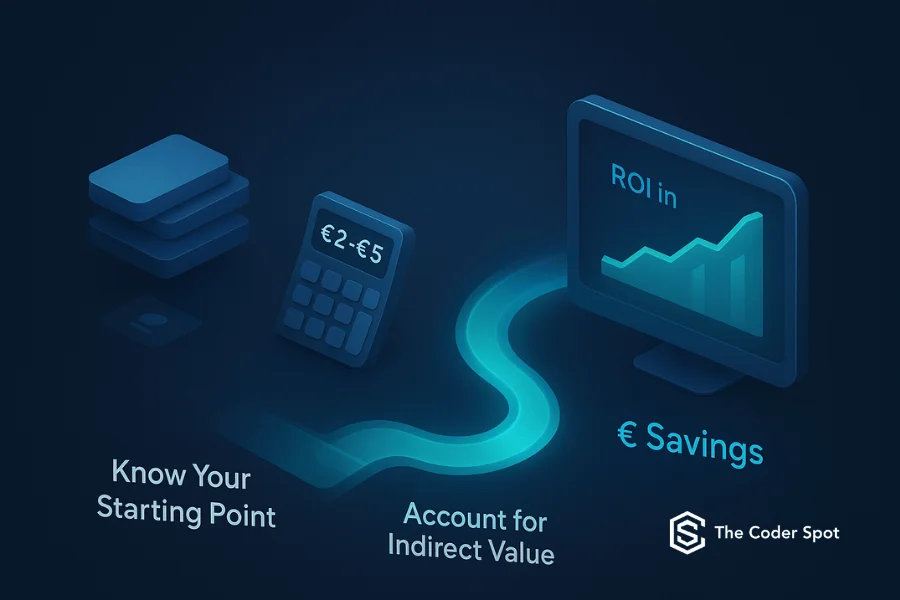AI document automation is becoming a key part of enterprise digital strategy. For C-Suite executives, the focus is no longer just on reducing manual work. The real question is: how can automation create new value, and how soon can we see that impact?
It explains how businesses can save money, improve decision-making, and lower risks by automating workflows that involve a lot of documents. We also explore where companies can see the biggest payoffs and how to justify investments in this area.
Key Takeaways
- AI document automation delivers rapid ROI — most enterprises recover their investment in under six months through cost savings, faster approvals, and fewer errors.
- Manual processes are costly and risky — businesses spend €2–€5 per document today, with added delays, compliance risks, and inefficiencies that automation eliminates.
- The value extends beyond savings — automation improves data quality, accelerates revenue cycles, reduces compliance risk, and frees teams for higher-value work.
- C-suite benefits are tangible — CFOs gain cost control, CIOs simplify system integration, and operations leaders achieve faster, more reliable workflows.
- Early adopters gain competitive advantage — delaying automation means higher costs, slower responses, and missed opportunities to unlock hidden business intelligence.
Why Document Automation Deserves Executive Attention
1. Rising Volume, Rising Complexity

Managing documents today means more than just dealing with volume. Businesses often run multiple parallel systems across departments, like ERPs for finance, CRMs for sales, and project tools for operations. Each system holds part of the story.
To maintain transparency across internal teams and external partners, businesses often rely on manual syncing, status checks, and reconciliations of data. This process is time-consuming and can easily lead to errors.
Invoices, work orders, contracts, and service reports are increasing not just in number but also in complexity. These documents move across departments, systems, and regulatory environments.
When managed manually, this creates delays. Tasks that should take minutes often take days. The costs of delays, errors, or rework can be significant. AI document automation addresses these issues by reading, extracting, and organizing data quickly and accurately at scale.
2. Rising Costs of Manual Processes
Handling documents manually requires more than just data entry. It involves chasing approvals, checking for errors, re-entering data between systems, and ensuring compliance. Each step adds time and cost. A typical business might spend several euros per document just to process it. AI can cut that cost by 60 to 80 percent.
3. Competitive Pressure
The automation landscape is evolving rapidly. Research from Gartner indicates that most businesses will implement document intelligence platforms within the next two years. Those who adopt early will get quicker access to insights, smoother workflows, and better cost control. Those who wait risk falling behind.
According to McKinsey’s 2023 AI report, companies that invest in AI automation see better results across operational KPIs. This is especially true when focused on specific uses, such as automating documents.
4. Revealing Untapped Business Intelligence
Businesses sit on thousands of documents that hold critical operational and customer insights. When handled manually, this data is locked away, often scattered across inboxes, paper files, or different systems. AI document automation doesn’t just save time. It gives companies structured, searchable data at scale. This unlocks patterns, reveals inefficiencies, and creates new opportunities for revenue and performance improvement.
How to Calculate the ROI of Document Automation

Calculating ROI isn’t only about labor savings. It’s also about transforming unstructured documents into insights that drive smarter decisions. That said, here’s a practical way to quantify both the direct and indirect value of automation. The core idea is to compare what you spend today with what automation can save you over time. Here’s a simple framework:
1. Know Your Starting Point
Begin by understanding how many documents your teams handle each month, including invoices, purchase orders, contracts, and service reports. Then, look at:
- Time spent on each document
- Average cost to process each document
- Error rates and costs of fixing mistakes
For many businesses, manual document processing costs between €2 and €5 each, not counting delays or fines.
2. Project Savings
AI Automation often cuts processing costs by more than half. It speeds up approvals, reduces human errors, and ensures more consistency. In most cases, companies recover their investment in under six months.
Example:
A logistics company typically processes about 50,000 documents each month at €3.00 per document.
With AI automation, the cost drops to €1.00 per document.
Annual savings: €1.2 million.
3. Account for Indirect Value
While cost savings are important, there’s more to ROI than reduced expenses. Automation also delivers long-term operational and strategic value:
- Improves accuracy and data quality
- Speeds up customer billing and revenue collection
- Lowers compliance risk with better audit trails
- Frees up teams to focus on higher-value work
- Creates structured data on a large scale. This unlocks trends and intelligence that manual workflows can’t capture
Where Automation Delivers the Fastest Results

Finance and Accounts Payable
Invoices and purchase orders are among the most document-heavy processes in any organization. AI can read and extract data from these documents, match them to records, and automatically route them for approval.
This speeds up payment cycles, reduces errors, and provides finance teams with better visibility into cash flow.
Operations and Field Services
Operations teams handle work orders, site reports, and job completion forms, which are often handwritten or submitted in different formats. AI helps standardize and digitize this information, reducing the time spent on processing field data.
This results in faster billing, better service records, and improved response times.
HR and Compliance
Human resources teams manage contracts, CVs, certifications, and onboarding documents. AI-powered automation simplifies these tasks by capturing and organizing the right information where it belongs. It also ensures that compliance requirements are consistently met.
A Practical View from the C-Suite

For most executives, the value of automation goes beyond saving time. It makes the organization more agile and better prepared to scale.
For the CFO: Automation reduces operating costs and improves the quality of financial data. It also lowers the risk of fines or failed audits.
For the CIO: It simplifies integration across systems and lays the groundwork for broader automation throughout the company.
For the Head of Operations: It enhances speed, consistency, and visibility. Teams can make faster decisions based on cleaner, more reliable data.
The Cost of Waiting

Delaying automation comes with costs. Each day that processes remain manual means:
- Teams spend hours on repetitive work
- Invoices are sent out late
- Errors go unnoticed
- Compliance risks increases
Over time, these costs add up. Companies that automate early not only save more but also move faster, respond better, and build smarter systems for the future.
Why Work with The Coder Spot
At The Coder Spot, we specialize in custom AI automation solutions for enterprises. We understand that your workflows are unique, and so is your ROI potential.
- We don’t offer one-size-fits-all tools. We build around your systems and goals.
- Our solutions integrate with your tech stack, whether that’s ERP, CRM, or legacy platforms.
- We focus on clear metrics, fast delivery, and long-term scalability.
Whether you’re just starting or looking to expand your automation footprint, we can help you identify where to begin and how to achieve real, measurable value.
Want to know what AI document automation could save your business?
We’ll analyze your current workflows and deliver a clear ROI estimate tailored to your business.













